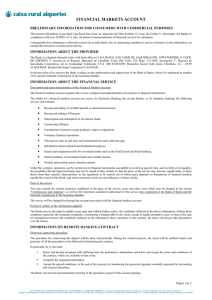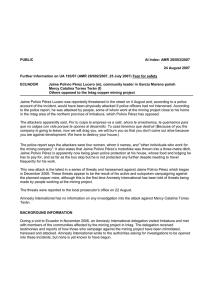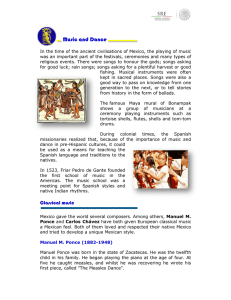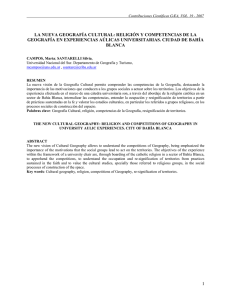investigación - Revistes Digitals de la UAB
Anuncio
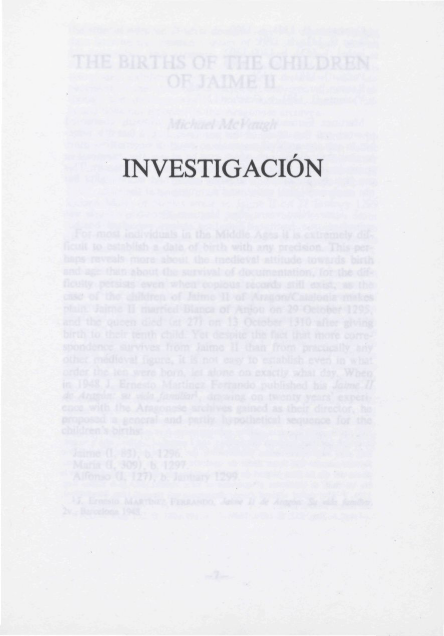
INVESTIGACIÓN
THE BIRTHS OF THE CHILDREN
OF JAIME II
Michaet McVaugh
For most individuáis in the Middle Ages it is extremely d¡fflcult to establish a date of birth with any precisión. This perhaps reveáis more aboul the medieval attilude towards birth
and age than about the survtval of documentation, for the difficulty persists even when copious records still exist, as the
case of Ihe children of Jaime II of Aragon/Catalonia makes
plain. Jaime II married Blanca of Anjou on 29 October 1295,
and the queen died (at 27) on 13 October 1310 after giving
birth to their tenth child. Yet despite the fact that more correspondence survives from Jaime II than from practically any
other medieval figure, it is not easy to establish even in what
order the ten were born, let alone on exactly what day. When
in 1948 J. Ernesto Martínez Ferrando published his Jaime II
de Aragón: su vida familiar*, drawing on twenty years' experience wtlh the Aragonese archives gained as their director, he
proposed a general and partly hypothetical sequence for the
children's births:
Jaime (I, 83), b. 1296.
María (I, 309), b. 1297.
Alfonso (I, 127), b. January 1299.
'J. Ernesto MARTÍNEZ FERRANDO, Jaime II de Aragón: Su vida familiar,
2v., Barcelona 1948.
Constanza (], 133) b. 1300.
Juan (I, 141), b. ¡301.
Isabel (I, 151), b. 1300-1302.
Blanca (I, 170, 310), b. 1302.
Pedro (I, 158), b. 1305.
Ramón Berenguer (I, 178), b. 1308.
Violante (I, 183), b. October 1310.
Martínez Ferrando was of course not primarily concerned
to work out the details of this sequence, but in fact it ¡s possible to use the archiva! materials to deveíop a somewhat more
precise chronology, one which can be of use (for example) in
trying to interpret the medical history of ihe royal family. This
can best be presented by treating each child individually, but
not in chronological order, and summing up at the end.
a) Jaime. Nine years after Martínez Ferrándoos work was
publíshed, the Instituí d'Estudis Catalans pubüshed posthumously an essay by Joaquim Miret i Sans (1919) on Jaime II's
primogénitas, which declared that Ihe Infante Jaime had been
born on 229 September 1296, eleven months after his parent's
marriage . This is perfectly consistent wtth the earliest known
direct reference to the Infante, a letter from the king to his
mother-in-law, Queen Maria of Naples, on 7 July 1297, assuring her that he, Queen Blanca, and the Infante Jaime were all
enjoying full bodily health. H is also consistent wilh the king's
grant to his consort on 8 November 1296 referring to 1«filiis
nostris communibus de nobis et vobis natis seu nacituris»- .
This reasonably secure date allows us to see Jaime II planning for medical care at the birth of his first child. In [ate
1295 and again in the spring of 1296, Jaime summoned the
physician Guillaume de Toulouse from Paris to his court. By
2iS August 1296 Guillaume was at the court in Valencia with
2
Joaquim MlRET I S A N S , El Forassenyat
Primógena de Jaume II, Barcelona
1957, p. 9, gives the date wiihout substantiation. lt is evidently based on the
marriage contraci between the Infante and Leonor of Castile, which
sing says «E) demás desto prometemos que des de ei dicho Infant
Jaymes nuestro fijo fuere dedat de quatorze annos los cuales (serán)
plidos del día de Sant Miguel de Setiembre primero que viene que ser
era de mili, et trezientes et quarenta et siete annos...» (A.C.A Cañ
1521, f. 81v; dated «primo día de deziembre era de mili. ccc. 46 a
see MIRETI SANS. p. 12.
3 A.C.A. Reg. 252, ff. 165v, 160v.
ihe litle of «fisicus illustris domine regine Aragonum»; eight
days later he was granted a salary of 2000 solidi yearly, and on
15 September was awarded houses nexl to ihe palace in
Barcelona, all for «servicia... nobis exhibita et que per vos
speramus... exhiberi»4. Presumably ihese servicia ¡ncluded supervisión of ihe binh of the expected baby; nevertheless, although the delivery was evidently successful, master Guillaume does not reappear in the Aragonese archives.
b) Alfonso. The second son of Jaime II and Blanca, who
became the heir to the throne when his older brother Jaime
renounced his position in 1319 (and who succeeded his father
as Alfonso IV of Aragón ¡n 1327), ¡s named ¡n a document of
15 March 1301 that orders a saddle and bridle to be taken to
him5, at a time when he must have been about two years oíd.
Queen María of Naples wrote to Jaime II on 28 January 1299
to announce that Blanca had just given birth to «un mout
beau fil sans grevance de son cors», a son
who (though there
unnamed) can only have been Alfonso6. We can thus fix his
birth securely ¡n January 1299.
c) María. This oldest daughter of the monarch is named in
a document of 67 June 1298, when a small grant was made to
her nurse Elvira . Her birth must have been only a matter of
weeks earlier. Learning unexpectedly that messengers from
Philippe IV of France were about to arrive ¡n his dominions,
Jaime II wrote immedialely from Xativa to Philip (as well as
to Charles II of Naples and Jaime II of Mallorca) on 26
March 1298 to explain that «nos... de partibus Regni Valencie
propter propinquitalem partus domine Regine consortis nostre
carissime non ita cito comode recedere poteramus»
and that
he was sending messengers ahead in haste8. The expected
birth presumably occurred, then, in April or May 1298 and
must have been that of María. It is worth remarking that
since, as we have seen, Alfonso was born just eight or nine
months later, his birth must have been premature; perhaps
this is why Queen María was so careful to reassure Jaime II of
«A.C.A. Reg. 194, fT. 253v, 250v, 257.
5A.CA.Reg. 268, T.47v.
6
Printed in MARTINEZ FERRANDO, V. 2, pp. 1-2.
' A . C A . Reg. 264. f. 417.
*A.C.A. Reg. 252, fT. 189v-191.
his new son's health and good appearance. It is likely that
master Hugo was the physician ¡n attendance —he at leasl was
the queen's physician during May-July 1298— and the fact
that Jaime II granted Hugo the considerable sum of 2000
silver luronenses on 9 January 1299, immediately befare Alfonso's birth, suggests that Hugo may have overseen the Infante's birth as well.
d) Constanza. The earliest direct reference to Constanza
that 1 have seen is of 12 December 13039, but still earlier
ones may well exist, for Constanza had evidently been born
more than three years befare. Giménez Soler quotes a document of 1306 as saying «el primero día deste mes de abril del
anyo contenido en esta carta en seys annos primeros
avenideros sera cumplida la edat de los doltze anyos»10. Thus Constanza appears to have been born 1 April 1300. Her birth occurred in Valencia and was probably overseen by Arnau de
Vilanova, who had arrived at court a few months befare and
on whom Jaime was to
depend increasingly for medical care,
and by Bernard Marini11.
e) Blanca. In a document of July 1314 published by Martínez Ferrando12, Blanca is referred to as having completed
«annum duodecimum sue etatis ¡n mense rnarcü proxime pretérito» — that is, she was born in March 1302. Sometine
befare November 1301 Ermengaud Blasi, the nephew of
Arnau de Vilanova, had been appointed the queen's
physician, but by January Ermengaud had returned to
Montpellier. On 27 January, therefore, the king wrote
to Arnau himself, urging his presence at the court in Valencia
and explaining that «consors nostra
in partu qucm gestat in
útero sperat in próximo expediri»13 (Bernard Marini had let't
9
E. GONZÁLEZ HURTEBISE. Libros de Tesorería de la Casa Real de Aragón,
v.I, Barcelona 1911, núm. 1549, p. 349.
10
Andrés GIMÉNEZ SOLtR, Don Juan Manuel, Zaragoza 1932, pp. 32-404.
11
On Arnald's presence in Ihe court at Valencia at this time, see P. MARTÍ,
«Regesta de documents arnaldians coneguts», Esiudis Francisians 47 (1935),
268-9, and referentes ihere. MARTINEZ FERRANDO, V. 1, pp. 136437, calis attention to an independent reference to Constanze's birth in Valencia. On Bernard Marini, see below, n. 22.
12
I3
MARTÍNEZ FERRANDO, V. 2, p. 108.
P. MARTÍ, «NOUS documents per a la biografía d'Arnau de Vilanova»,
Analecia Sacra Tarraconensia 11 (1935), 100.
for France a month before). A letter of 28 April 1302 shows
that Arnau had come to court and was preparing
'
thal
to leave
again; the birth had appart
apparently had no complLCations'4.
0 ¡sabe!. The date —even the year— of Isabelas birth has
puzzled historians for some time. Zeissberg suggested the year
1300, bul did not make his reasoning entirely clear. He appears to have believed Ihat ¡n order for Isabel to have married
in January 1314 she must have been born at least twelve
years before, and, since he assumed that Juan was born in
1301 (for reasons we will see below), he supposed that Isabel
had to have been born the previous year as a twin to her
sister-whom at one point he calis
«Blanca» but elsewhere inv
plicilly identifies as Constanza15.
This confusión can be avoided now that we have acknowledged that Blanca was born in March 1302. Isabel was indeed
already born by this time, as Zeissberg inferred (she is named
in a document of 14 December 1301'"), and the normal ninemonths' pregnancy that seems to underlie the unworried
letter quoted above from Jaime II to Arnau de Vilanova
dated January 1302 would imply that Blanca's conception occurred in June 1301 and thus that Isabel's birth came no later
than May 1301. Constanza had been born just a little over a
year earlier. Constanza and Isabel could still have been twins,
but there is no need to suppose the relatively rare occurrence,
since all our facts are consistent with a date of February-May
1301 for the latter's birth.
g) Juan. In trying to fix the date of Juan's birth, it is tempt'4Michael R. MCVAUGH, «Further documenis for the biography of Arnau
de Vilanova», Dynamisl (1982), 368-9 (doc. 60a).
15
Heinrich RITTER VON ZEISSBERG. «Elisabeth von Aragonien, Gemahlin
Friedrich's des schonen von Osterreich (1314-1330)», Siizungsberichte der
Kais. Akademie der Wissenschqften in Wien, Phil.-Hist. Classe, Bd. 137 (Wien
1898), VII. Zeissberg suggests in his lable on p. 33 ihat Blanca was born at
the end of 1299 or the beginning of 1300, and that henee Isabel could have
been her twin; he does not mention Constanza here. Yet on pp. 11-12 he
recognized that Constanza was ihe second daughter and Blanca the fourth,
thus ¡mplicitly making Isabel a (hypothetical) twin of Constanza. MARTINEZ
FERRANDO (V. 1, p. 151) fbllows the argument on p. 33 rather than that presupposed by p. 11.
I6
A.C.A. Reg. 294, f. 29, ordering a payment to be made lo her nuirix.
ing to begin from the inscription on his sepulture at Tarragona
Cathedral, which states that he died 19 August 1334, «anno
. vero etatis sue 33». But it ¡s probably safer to start instead
with a letter from h¡s father Jaime II lo the Cardinal-Bishop
of Tusculum, dated 14 November 1313, which reads ¡n part:
quando... tonsuram ei tradidit clericalem speciali privilegio concessit eidem quod in vicésimo etatis sue anno ponlificalem dignitatem recipere valeret libere... et cum esset tune memoratus
infans in nono, nuneque sit in anno undécimo constitulus,
poterit ipse17 dominus summus pontifex... defTectus supplere
predictos...
The Infante Juan was accorded the lonsure on or very near
to 11 June 131118. Jaime's letter would ihus imply that Juan
was eight, not yet nine, in June 1311; and ten, nol yet
eleven, in November 1313; or, taking the lwo statements
together, thal his birth 19took place belween 15 November
1302 and 10 June 13O3 . This is enlirely consisten! with a
series of letters from
the Avignon popes to Juan, making
reference to his age30, which indeed can be used to narrow
down still further the period in question. A lelter of Pope
John XXII dated «5 kals. Apr. pontificatus nostri anno
17 A.C.A. Reg. 349, f. 16. Johannes Vincke, «Jacob II. und Alibns IV. von
Aragón uno die VersorguriG des Infanten Johann mit kirchlichen fr Linden»,
Rómische Quanalschrift 42 (1934), 6, n. 3, says mistakenly thal ihis dotument
places Juan «im 12. Lebensjahr».
I8A.C.A. Reg. 349, f. 69.
19
Olher wrilers have assumed impliciily ihat «anno etalis sue» is a direct
Índex to the number of birthdays passed. Thus Vincke (toe. di.) writes
«Nach seiner Grabschrift in der Kathedrale zu Tarragona starb Johann von
Aragón am 19. August 1334 «anno vero aetatis suae 33». Danach wird er in
der Regel ais 1301 geboren bezeichnet». Surely, however, the phrase means
that he had had 32 but not ye! 33 birthdays, so that the inscription implies
that he was born between 20 August 1301 and 18 August 1302, or on balance
in 1302 rather than 1301. (Cf. the usage quoted in nn. 20 and 21 below).
20
E.g., in letters of Clement V: «in nono etatis tue anno constitutus existai» (dated «id. Jim. pomificatus nostri anno sexto» or 13 June 1311; A.C.A.
Reg. 349, f. 70); «in undécimo etatis tue anno vel circa illum consistas»
(daied 13 kals. Jun. pontificatus nostri anno octavo» or 20 May 1313;
A.C.A. Reg. 349, f. HOr-v). The latter phrase is repeaied in the letters thal
follow -fr. lllv-112, 113v, 115v- all but one of which bear the date
«13 kals. Jun.». The exception, at í. 113v, is misdaied «13 kals. Jul.» and it
is this mistaken date that is quoted by Vincke (loe. di).
primo» (25 March 1317 —John was elected pope in August
1316) says that dictus Johannes... in quintodecimo elatis sue
anno constitutus fore noscatur», indicating that the Infante
had already had his fourteenth birthday by this date21. In
other words, the Infante Juan seems lo have been born between 15 November 1302 and 25 March 1303. The Tarragona
inscription, prepared over thirly years later, has to be acknowledged as incorrect: on 19 August 1334 Juan would have been
in his 32nd year, not his 33rd.
Medically — biologically— this daling of Juan's birth presents
no difficullies. The previous child of Jaime II and Blanca had
been their daughter Blanca, born as we have seen in March
(perhaps early March) of 1302. Juan could thus have been
born premalurely ¡n November or December 1302, or after a
normal nine-months term in January-March 1303. Both
Arnau de Vilanova and Ermengaud Blasi were absent from
the court during much of 1302-1303, and
the principal royal
physician was at first Bernard Marini23. But in Seplember
1302 Bernard left the court with an urgent message and summons for Jean d'Alest of the medical faculty at Montpellier, a
physician selected al the recommendation of «nonnullos in
nostra curia» to replace Bernard. Perhaps Arnau or Ermengaud
had spoken highly of Jean; they would have known each
other teaching at Montpellier, and Arnau and Jean were laler
to work together on the revisión of the medical faculty's curriculum there. Jean seems to have arrived in Catalonia in Octo2IA.C.A. Reg. 349, ff. 118v-M9.
"Bernard Marini first appears in royal service in February 1300 (Reg.
294, f. 1 Iv); lwo months later, on 20 April, he was granted 1000 s. yearly on
ihe tribute of Ihe affama judeorum of Barcelona, for «servicia... nobis et illustrissime domine regine eonsoni nostre karissime exhibita» (Reg. 197,
f. IO4v). Corning as il does only a few weeks afier [he birth of the Infama
Constanza, this granl suggests a reward for assistance at the suceesful
delivery- Another grant, this lime an outright gift of 6000 s. for services to
ihe king and queen, was made 11 December 1301 (Reg- 268, f. 250). Six
days later ihe king provided Bernard with credentials for a trip to visil
friends and relalives in France (Reg. 120, f. 174). bul by June 1302 he was
back al ihe royal court. In Augusí ihe king gramed him reimbursement
totalling 3012 s. for books and oiher Ítems losi in a shipwreck (Reg. 294,
ff. 65v-66). Then in Seplember Bernard consolidated the sums owed him by
thc court (Reg. 269, f. 87), gave up his yearly grant from Ihe Barcelona
aljama (Reg. 125, f. 1), and lefi Ihe court for good, travelling via Montpellier
to consuli wiih Ihe physician Jean d'Alesi (Reg. 125, IT. 55v-56).
-13-
ber 1302 and to have left early in February 13O323. Nowhere
in the royal correspondence of this period are ihere allusions
to some acule illness at court that could explain his summons,
and it seems possible that Jean was meanl to replace Bernard
in supervising the queen's pregnancy. His departure in February would then mean that by this time the Infante had been
born and was in good health; from what we have seen of
him, Jaime II would not willingly have allowed a famous physician to leave his court if the queen's delivery had been only
a few weeks away. On balance, then, perhaps we can conclude
that the Infante Juan was born in November or December
1302, in which case he, like his brother Alfonso, would have
been a premature baby.
h) Pedro, The case of the Infante Pedro raises difficulties of
another sort. I have not come upon a direct reference to
Pedro earlier than May 1308, and our only clue as to his date
of birth comes in his own account of the revelations that
carne to him late in life and led him to join the Franciscan
orden «yo rehebi lo sant abit de mossen sent Francesch lany
de la Incarnacio de Jesu Christ mil. CCC. LVIII et en lany de
mi dit frare Pere Lili anys» (in fact, his entrance into the
order carne on 12 November 1358)24. This wording suggests
that at that moment Pedro was between his 52nd and 53rd
birthdays, in his 53rd year, and henee that he was born
between November 1305 and November 1306. By this time
Ermengaud Blasi had returned to the court as its principal
physician, and he would probably have attended the queen. It
" O n 29 Ociober 1302 Jean d'Alest was granted 500 s. monihly for as long
as he remained in royal service (Reg. 269, f. 103). By 22 November (Reg.
294, f. 81v) he had been paid 152 s. for his travel expenses (rom Montpellier
to Gerona; by 29 November (id., f. 82) he had been paid a further 200 s. for
his Ociober expenses. He received 500 s. on the firsi day of December 1302
and of January and February 1303, after which all payments stopped (A.C.A.
Real Patrimonio, Reg. 774, f, 36v).
34
Quoted by Josep Maria Pou, Visionarios, beguinos y fralicehs catalanes
(Vich 1930), p. 350. The study by Alfonso María de Barcelona, «El Infante
Fray Pedro de Aragón» Estudios Franciscanos 11 (1913), 132-6; 12 (1914),
129-41, 434-8; 13 (1914), 204-15; 14 (1915), 205-18; 15 (1915), 58-65,
seems not to have been completed and offers no further informaüon, saying
only «nos inclinamos a creer que nació en el año 1305, en conlra de lo que
hemos leído en algún autor, loda vez que él mismo dice en sus escritos que,
al entrar en la orden seráfica, en 1358, tenía cincuenta y tres años de edad».
¡s suggestive that after seven pregnancies in six years, the
queen had not borne a child ¡n three or four years, and ¡t is
tempting to wonder whether belween 1302 and 1305-1306
there were other pregnancies that d¡d not reach term.
A further piece of evidence may allow us to narrow down
the possible date of Pedro's birth a little furlher. A lelter from
Jaime II to the king of Mallorca dated 22 September 1306 excused him from a meeting on the grounds that Queen Blanca
was then suffering from a quartan fever; surely if she had
been far along in pregnancy, Jaime would
have mentioned
this fact as well in making his excuses25. In all probability,
then, Pedro was born before September 1306.
i) Ramón Berenguer. This last son of Jaime 11 and Blanca
was born in 1308, at least lwo and perhaps three years after
Pedro, their previous child, and this comparatively long
period of lime again suggests that Blanca may have been experiencing difficulties ¡n pregnancy. A remark in her will (signed
in Valencia, 18 August 1308) indirectly supports this
hypothesis, stating Ihat she is drawing it up «iuxta nostrum
puerperium existentes, partusque nostri periculum obstupenles
ob multa pericula que emergunt femíneo
sexui ante partum et
¡n partu similiter et post partum»26. Less than two weeks later
the child —Ramón Berenguer— was born, on 31 August
1308: writing in September, King Fernando of Castile congratulated Jaime II on the birth of a son on the «postrenero dia
de agosto»27.
By this time Jaime II had acquired the two physicians who
were to serve the court for the remainder of his reign, Joan
Amell and Marti de Caliga Rúbea. Ermengaud Blasi had left
royal service for good al the end of 1306, shortly after the
birth of trie Infante Pedro. Before leaving, he had recommended thal Joan Amell be appointed to care for the royal
children, and the latter had arrived in November 1305; within
a few years he dad received the title of phisicus major, and
kept it into the reign of Alfonso IV. Maní de Caliga Rúbea
had been at court since late 1304, but he too became important only after Ermengaud's departure. Although the king con" A . C . A . Canc. Reg. 236, f. 237.
The document is published by Martínez Ferrando, v. 2, pp. 34-39.
A.C.A. C.R.D. Jaime II 3363, dated 19 September era 1346 { = 1308).
26
27
tinued lo consult a variety of other physicians, he never again
suffered the inconstancy of medical assistance that marked ihe
first 15 years of his reign. In August 1308, then, both Joan
Amell and Martí de Caliga Rúbea were at court, and both
may have attended at Ramón Berenguer's birth.
j) Violante. In a letter of 14 October 1310 ihe king wrote
that Blanca had died after giying birth lo this their last child,
«post dolores gravissimos, quibus racione partus sui extitit per
dies aliquos multipliciter lacessita...
die martis proxime pretérita» —that ¡s, on the 13th28. The register of the queen's correspondence in her last years stops with a quantity of letters
dated 11 October 1310, and it would be consistent with
Jaime's account to suppose that the birth occurred then, with
Blanca dying two days later.
In this way we may arrive at a new sequence for ihe births
of the children of Jaime II and Blanca:
Jaime: b. 29 September 1296 (Valencia).
María: b. April/May 1298 (Valencia).
Alfonso: b. January 1299 (Naples).
Constanza: b. 1 April 1300 (Valencia).
Isabel: b. February-May 13OI29.
Blanca: b. March 1302 (Valencia).
Juan: b. November-December 1302.
Pedro: b. 1305-1306.
Ramón Berenguer: b. 31 August 1308 (Valencia).
Violante: b. 11 Oclober 1310 (Barcelona).
28
Pub)< hed b> Martínez Ferrando, v. 2, pp. 40-41.
29
In hi Jaumi II o el seny caíala (Barcelona 1956), p. 160, Martínez Ferrando suggested that Queen Blanca gave birth to a child in Murcia in March
1301 H e gave no reason for his suggestion, and I have not yet found documentation to support it, h u t if it is correct the child
-16-
